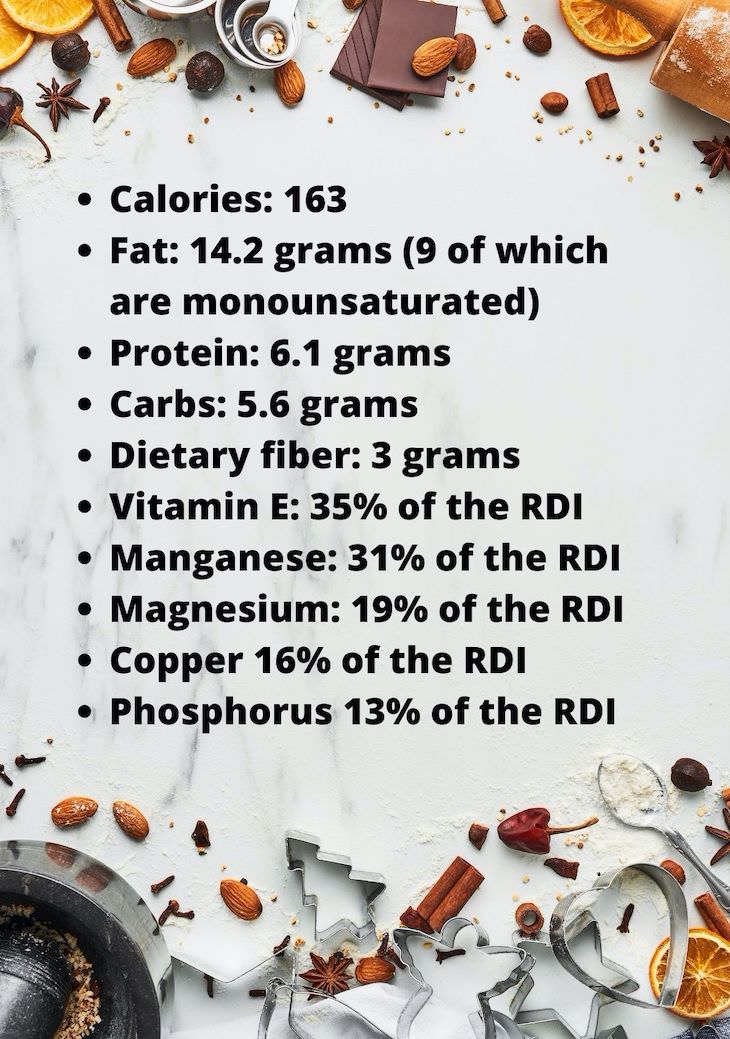What is almond flour?
Almond flour is made from - you guessed it - almonds. The process involves blanching almonds in boiling water to remove the skins, then grinding and sifting them into a fine flour. It’s important to note that almond flour is not the same as almond meal, despite the fact that their names are sometimes used interchangeably. The main difference is that almond meal is made by grinding almonds with their skins still intact resulting in a coarser flour. So if a recipe specifically notes that it requires almond meal, do follow it, as it makes a big difference in texture.
The health benefits of almond flour vs. wheat flour
The main thing that makes almond flour such a desirable alternative to wheat flour is how rich it is in nutrients, as per the table below. One ounce (28 grams) of almond flour contains:
*RDI stands for 'Reference Daily Intake'
As you can see, almond flour is rich in magnesium, which is vital for several processes in your body, including improved blood sugar control, reduced insulin resistance, and lower blood pressure. These properties give almond flour a low glycemic index, meaning it releases sugar slowly into your blood to provide a sustained source of energy. In fact, this ability to improve insulin function, and its high magnesium levels could be highly beneficial to those suffering from type 2 diabetes, according to Healthline.
Fat and fibers can also be found in abundance in almond flour. That stands in contrast with refined wheat, which is high in carbs, but low in fat and fiber; this can cause spikes in blood sugar levels, followed by rapid drops which can leave you feeling tired and hungry.
Both wheat and almonds contain high levels of phytic acid, an anti-nutrient that impairs the absorption of iron, zinc, and calcium and may cause problems like gut issues, tooth decay, and nutrient deficiencies. However, the phytic acid in almonds is mainly found in their skin, so almond flour loses this harmful ingredient at the blanching stage, unlike almond meal, which, as we mentioned, is ground with the skins.
While being the overall healthier option when it comes to nutritious value, it should be said that because almond flour is higher in fat than wheat flour, it is also higher in calories. Regardless, those calories are preferable, as they do come with health benefits that cannot be found in wheat flour - insulin normalization, reduction of bad LDL cholesterol, and richness in important minerals such as zinc and magnesium.
Is wheat flour ever the better choice?

With all the praise for almond flour, can wheat flour ever be the preferable choice? Well, yes. It all depends on what you want to cook. Wheat flour is, after all, an essential product and is incredibly versatile. Unlike almond flour, the main protein in wheat flour is gluten, which is what causes the dough to be more elastic when kneaded. While almond flour is best preserved for baking, when it comes to savory dishes it is pretty limited. Even when using almond flour for baked goods, keep in mind that they tend to come out more flat and dense than they would with wheat flour.
Another upside of wheat flour in baking and cooking is that it doesn't alter a recipe’s flavor at all. Since almond flour is made of almond, it has a nutty flavor which might not go with every flavor profile.
How to swap almond flour for wheat and vice versa
To swap almond flour for wheat flour, simply follow the 1:1 ratio. For example, use the same amount of almond flour as you would wheat flour. The same goes for substituting wheat flour for almond flour. Do not pack the cup of almond flour, as it’s denser and heavier than wheat flour.
Do keep in mind that when baking with almond flour, recipes will need to be altered a little, as you will need a binding ingredient such as an egg, to compensate for the lack of gluten.
So what's the bottom line?
The bottom line is that out of the two, almond flour is richer in nutrients than wheat flour, and has superior health benefits. However, if you need versatility and flexibility, wheat flour is the way to go. Moderation is the keyword. For those who are gluten-free, well, the choice is very simple: almond flour all the way.
Share this article with everyone who's interested in nutrition and health!
 Go to BabaMail
Go to BabaMail























































